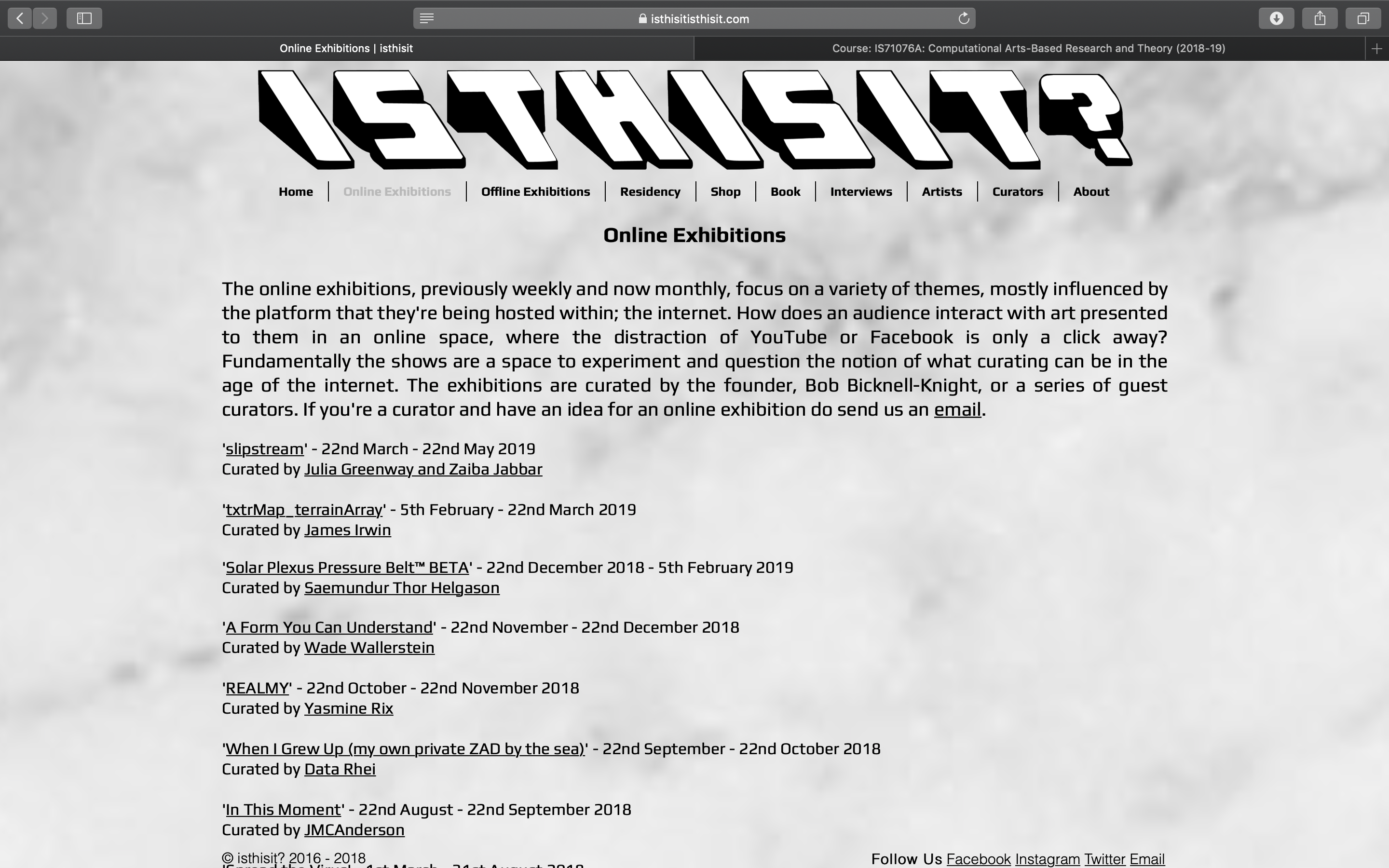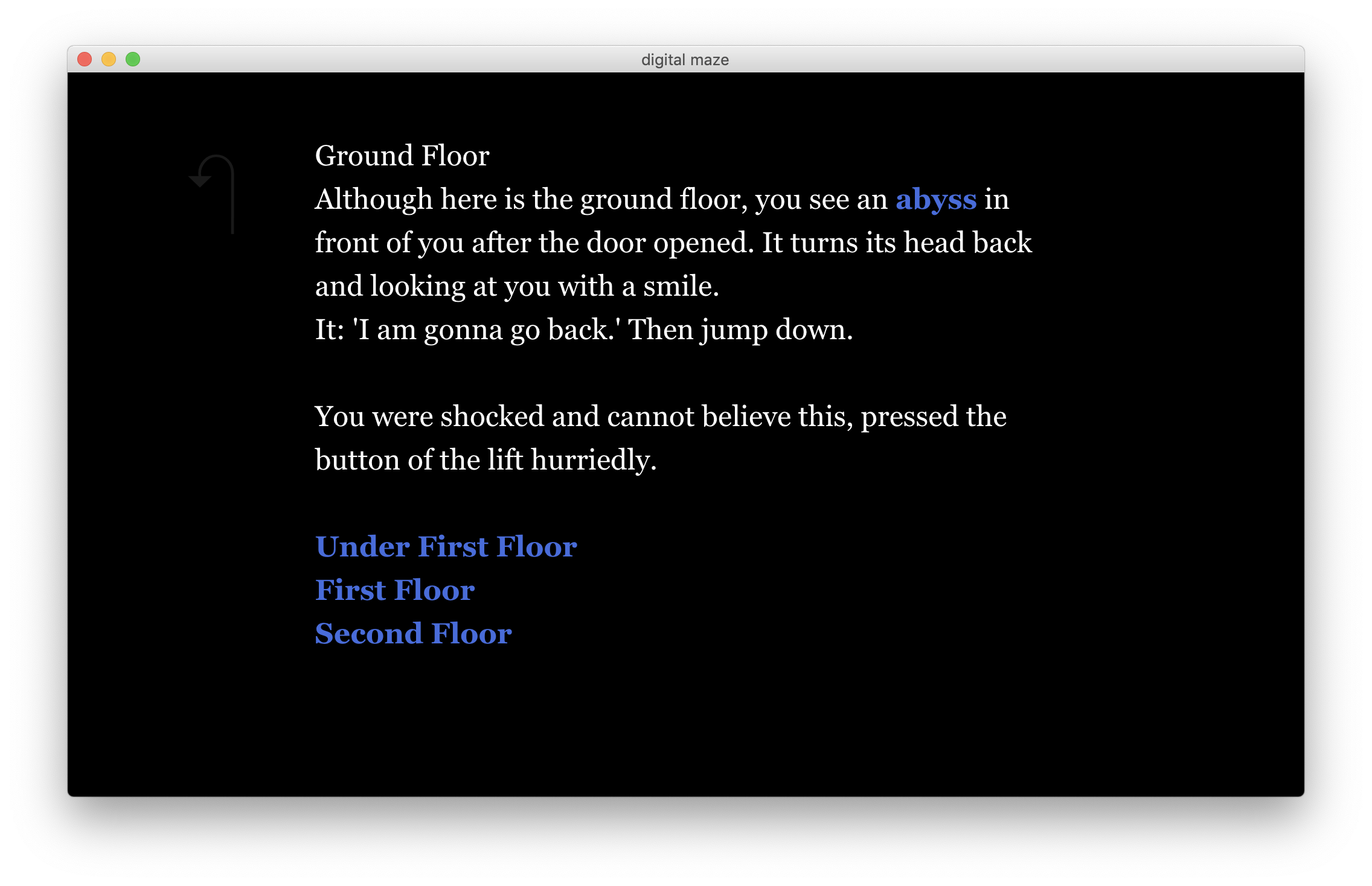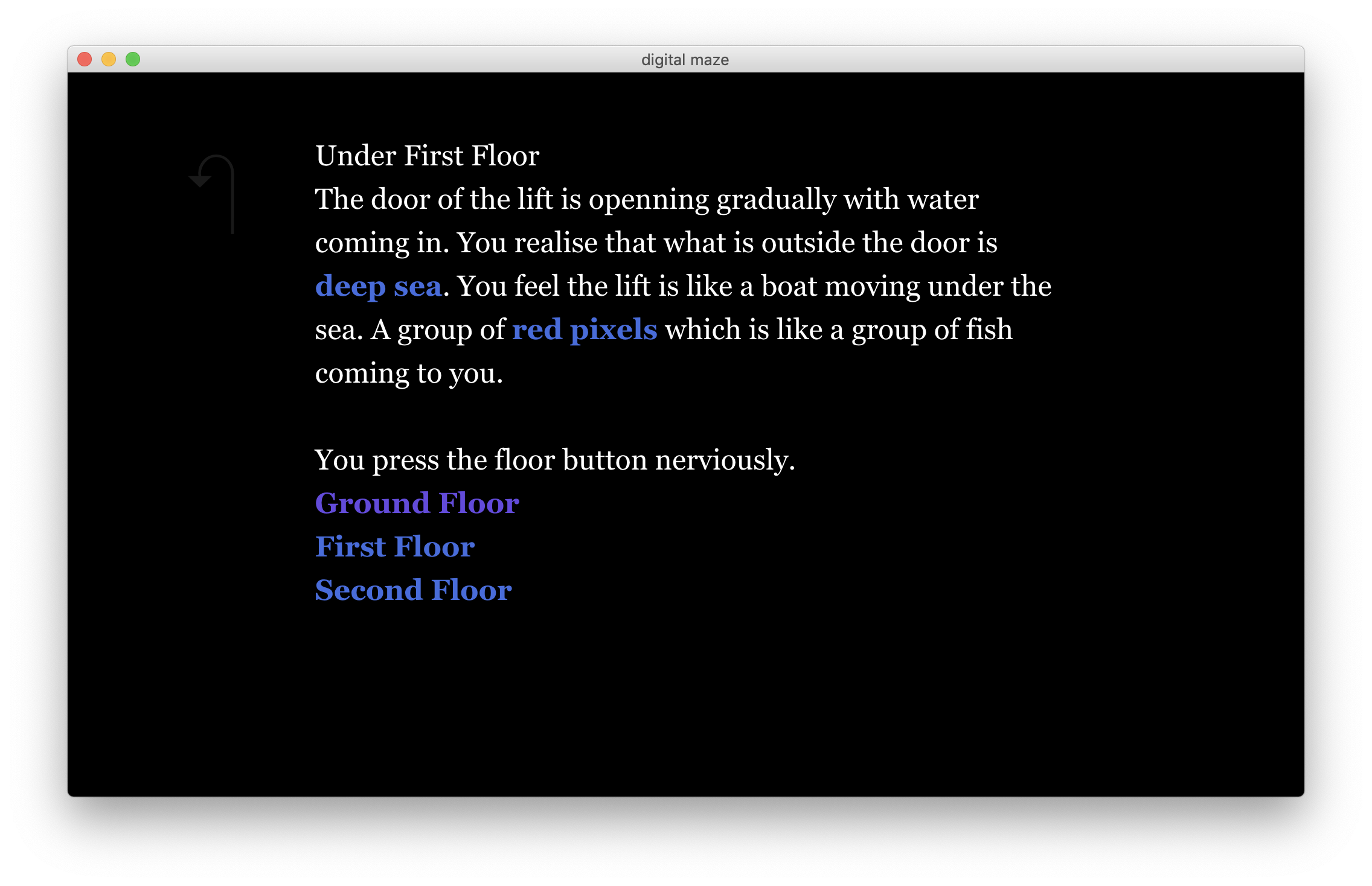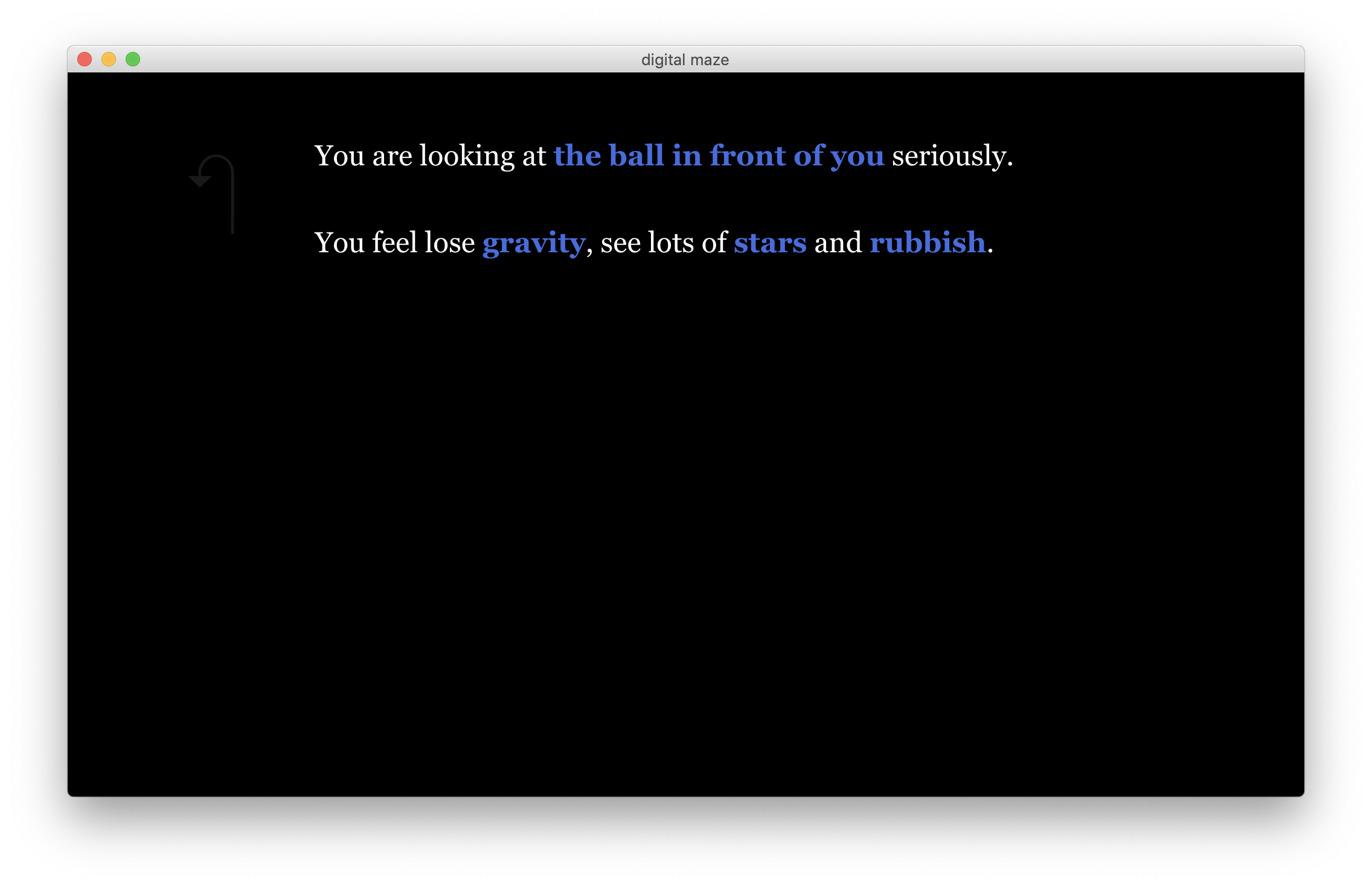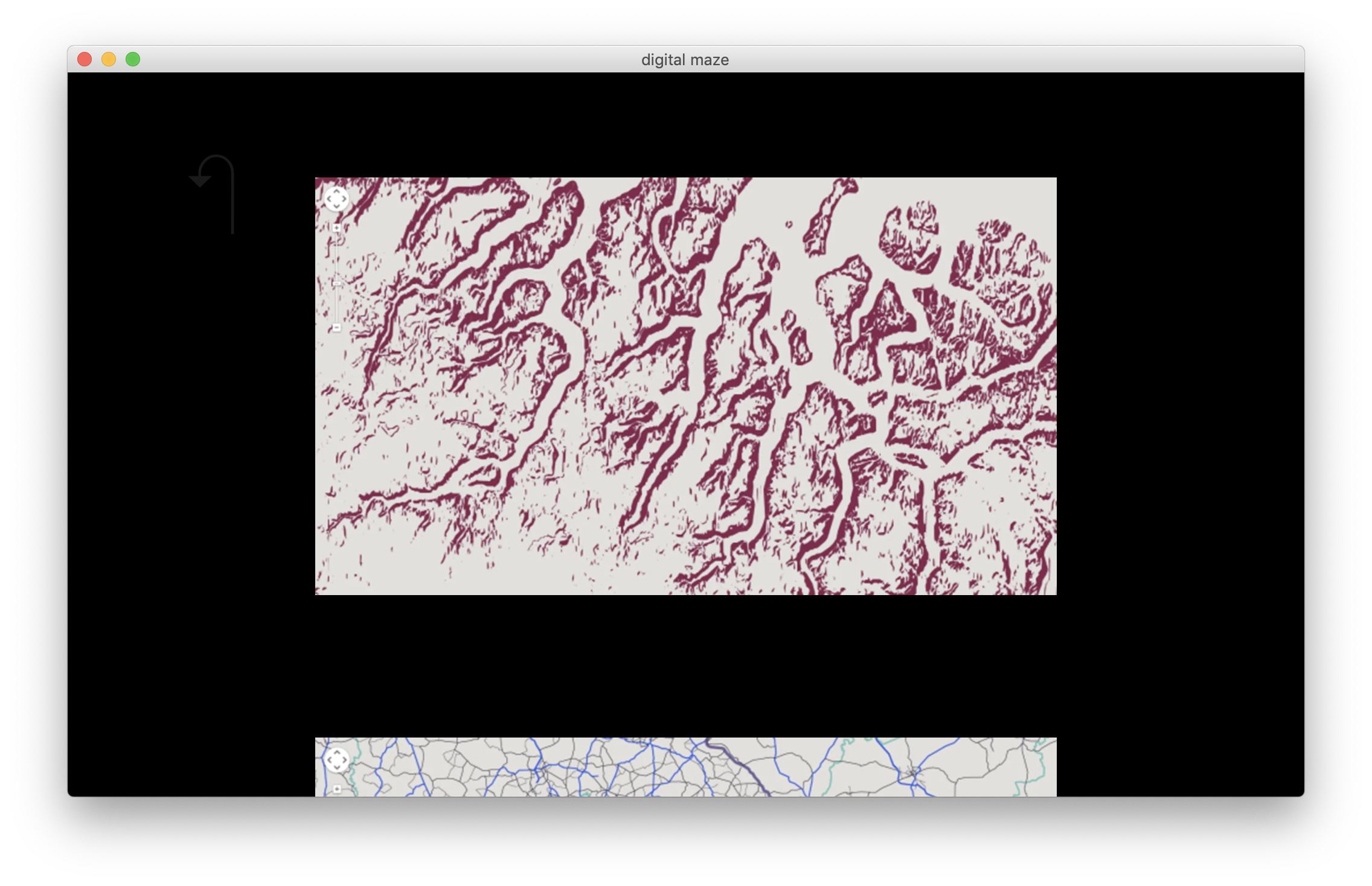Online Curating: Let’s Game
Produced by: Baqi Ba
Recently, there has been mounting interest indigital media arts, resulting in a number of digital media art exhibitions of online net art around the world. It is therefore worth considering the notion of online curating.Boris Gorys (2018) claims that the internet frames the world for its users, but it does not reveal its own framing, while most of online exhibitions are done by curators in actual practice, which has the same logic as curating in real space based. However, these discussions have tended to focus on comparison between online curating and curating in real space based, rather than from a specifically one in network environment. The aim of this essay is to evaluate the notion of ‘online curating’ in network environment from a circular-causalloop relationship between curators and viewers. It willfirstly examine the current state of ‘online curating’ exhibitions from both network-environment and traditional curating perspective and then analyze specific examples of online art events to discuss how to curate an online exhibition by both curators and viewers based on a causal-loop relationship between them.
For online exhibitions, there is a main part running those exhibitions that cannot be seen by viewers, but it is meaningful and necessary. Online exhibitions are as interfaces connect data system and human. That is to say, online exhibition cannot be built if it is lack of this part, that is data calculation. Actually, this part is hidden by curating team in most of currently online exhibitions. Since,normally, curators can decide everything in a traditional exhibition. For those whose most of work are digital media, curators still can control the structure of an exhibition in a space, while viewers are at the outside of an exhibitions. Outside here means viewers cannot take part in the process of building an exhibition, what they can do is merely visiting, watching, thinking and criticizing. They cannot decide how the exhibiting line is, in which way they make a relationship with art works or the whole exhibition. In other words, viewers rely on what curators offered them. On the other hand, artists are as content providers on the internet. The process of organizing those contents is curators’ responsibilities. That is to say, curators as collectors and organizers of information to filter such kind of spam, as well as principle designers of the exhibition. What they need to consider is how to process the information through data system, which aims to communicate with viewers. Therefore, facing the differences between internet and real space, what is the thing that curators are going to offer viewers? Images are one of the most basically elements on the internet and exist in every website. What curators need do is not only collecting those images, but also curate them.
Based on the spatial and temporal relationship between inner and outer screen, there will be non-liner and multi-layered interactions among curator and differently individual views. During this interactive process, a circular-causal relationship will be created between inner and outer interface. For example, when people play computer games, players and data system will reflect to each other through the interface. These reflection reveals that the part being hidden back of most online exhibitions. In this way, the exhibition would be curated by a collaboration of curator and viewers. In addition, what can be decided by viewers is between single work and viewers. The fundamental differences between online curating and real-space curating. Causal-loop relationship between curators and viewers can be looked as the one between data system inner computer and human outer computer, as well as between internet and reality.Although comparing with reality, network environment is more open, at the same time it is more individual. That is to say, all the online contents can be broaden much faster and more far without geographical distance, as well as can be received in many different ways which depend on who the receiver is.
According to these, I am going to talk about how to curate an online exhibition based on game. Game are created based on data system definitely. As Brenda Laurel(2004) said,‘Real-time human-computer interaction is a mediated collaboration between designers and interactors.’ For online curating, curators could be looked as designers, and viewers of an exhibition could be looked as interactors. That means curators and viewers need co-create an online exhibition together, especially viewers need participate in the process of building an online exhibition, but merely curators decide everything. Thus, curators cannot predict what would happen before one viewer leave the online website. That is to say there will not be an online exhibition without viewers.
IsThisIt?
Screenshot of IsThisIt?
There are two main online parts at IsThisIt?, including online exhibition and online residency. They hold offline exhibitions in their physical space as well, which is not such related to their online space, so it will not be discussed here.
- It can be seen that all the past exhibitions were kept on this website. That means online space for exhibitions can be presentational platform, as well as collecting platform at the same time. But at the same time, that means it is lack of an exhibited duration.
- For the duration of an exhibition, it is based on the calculation of daily time, like 24 hours per day, which is the same as the typical exhibitions in reality with a specific starting and ending time. On the other hand, what is worth to be questioned is why the past exhibitions still can be seen with a specific duration?
- Most of forms of exhibited work are digital work, including photography, network… In this case, every single work is looked as an object, as well as an event at the same time. ‘Events’ is from its interaction. Although viewers can do some kind of interactive behaviors, there is no actual interactions between curator and viewers, among viewers as well, which means they cannot communicate with both each art work and other viewers when they are watching an exhibition or afterward an exhibition. That reveals online function has disappeared in this exhibition when visiting this online space as an exhibiting space. In other words, viewers will lose lots of their emotion without any participations in this exhibition.
Sunrise & Sunset, AtrPort, Whitney Museum of American Art
Screenshot of Sunrise & Sunset
The main online gallery of Whitney Museum includes three parts, commissions, documentation and collection. The series of Sunrise & Sunsetat this online space will be the main focus in this session. As they presented on the official website,
- The exhibition, it also can be said a program, could be updated continually. That is to say, it broke the limitation in real time and white cube. Both time and space online can be broaden without this limitation.
- Result from above, every single work has a specific duration which is distinguish from IsThisIt?.For example, in the case of Sunrise & Sunset, its starting and ending time is connected with real time through American sunrise and sunset time. Although it also uses a ready way to calculate time, the sunrise time and sunset time always keep changing following the moving of planets. Furthermore, there is a geographical function within in this work. It would bring people who are outside American time zone into their own biological clock. It has been argued by Boris(2018) that local exhibitions often exhibit international art works. In other words, geographical location is easier revealed than biological time for real-space based curating. But for online curating, how to rule the exhibiting time is more important, because geographical limitation is totally destroyed on the internet.
- What another difference from the last case is that their past exhibitions can not be visited by viewers at the online space, but the information of past exhibited work is still shown on the website. Since it is a continued program, the first work of this series was exhibited from December, 2009, but the ending time cannot be sure. Thus, this program can be looked as a generative system with a basically regular rule made by curator.
- In this case, artists are as content providers as well as a part of this exhibition. But all art work in this program are networks which include interactive behaviors originally. Thus, curator is at the state of collector in this exhibition. What viewers are interacting with is the single art work when visiting this website, but the exhibition.
Screenshots of Digital Maze
Following those opinions that I discussed before, I tried to make a structure of online exhibition whose topic is related to google maps, called Digital Maze. This structure mixes couples of functions of both game and exhibition. As Brenda Laurel said, ‘Game are the easiest of computer activities to translate into the language of the theatre…’ The game/ exhibition, for players/ viewers, is about looking for where they are, happening in a chaos space and era. What I focus on firstly is about how digital narratives can break the distance and time,so there are lots of links which can go to other websites outside the exhibition can be seen in this structure. The second one is the relations between inter interface and outer interface, which means that between game designers/curators and players/viewers. Therefore, I tried to create this structure with a story totally made of fragmental footages as the elements. Although curator is a provider of contents in this case as well, the whole exhibiting environment became more open. Viewers can create a narrative through organizing those contents and making a sequence by themselves to create a narrative. That is the reason why it contains a story is that aims to draw viewers’ continuedattention. It would be helpful to build the exhibiting atmosphere to help people take part in an exhibition. When game will be over is decided by viewers themselves (click the website button). During this process, a ‘causal-loop’ relationship between inner and outer interface will be created. It can be said that the exhibition is curated by game designer/ curator and players/ viewers.
In conclusion, although there are lots of factors that can influence the curating of an exhibition, it seems that the most basic attributes of online space are not fully exploited for most of current online exhibitions. That is to say, they lack some characters that they should have of an exhibition real-space based at online space.If real-space based exhibitions built an ambience through arranging its space to distinguish an image in an exhibition and other images on the street for viewers to access those archives in the museum, what is needed to consider is how online exhibitions can offer an exhibiting ambience to distinguish an image on the exhibiting website and other images outside it for their viewers. However,there should be a thinking on how can keep people being engaged in an online exhibition continually. Moreover, online exhibition could be looked as a system, which means online curating aims to create a system can be interacted each other between inner and outer interface.
A test file of Digital Maze
Reference
Sommerer, C. and Mignonneau, L. (1999). Art as a living system. In: E. Shanken, ed., System, 1st ed. London: Whitechapel Gallery, The MIT Press, pp.172-176.
Laurel, B. (2014). Computers as theatre. Upper Saddle River, NJ: Addison-Wesley.
Groys, B. (2015). The Mimesis of Thinking. In: E. Shanken, ed., System, 1st ed. London: Whitechapel Gallery, The MIT Press, pp.140-144.
E-flux.com. (2019). Curating in the Post-Internet Age - Journal #94 October 2018 - e-flux. [online] Available at: https://www.e-flux.com/journal/94/219462/curating-in-the-post-internet-age/ [Accessed 11 May 2019].
Yuk, H. (2018). Preface: The Time of Execution. In: H. Prichard, Snodgrass, Tyżlik-Carver, ed., Exciting Practices, 1st ed. Open Humanities Press, pp.25-34.
Birnbaum, D. (2007). Chronology. New York, NY: Sternberg Press.
Graham, B. and Cook, S. (2010). Rethinking curating. MIT Press.
Gillette, F. (1973). Notes fir a Proposal on Conceptual Gaming. In: E. Shanken, ed., system, 1st ed. London: Whitechapel Gallery, The MIT Press, pp.75-78.
Steyerl, H. (2011). Digital Debris: Spam and Scam. In: L. Larsen, ed., System, 1st ed. London: Whitechapel Gallery, The MIT Press, pp.110-117.
Whitney.org. (2019). exonemo: 0 to 1 / 1 to 0. [online] Available at: https://whitney.org/exhibitions/exonemo [Accessed 11 May 2019].
Isthisitisthisit.com. (2019). [online] Available at: https://www.isthisitisthisit.com/is-this-it [Accessed 12 May 2019].
En.wikipedia.org. (2019). Cybernetics. [online] Available at: https://en.wikipedia.org/wiki/Cybernetics [Accessed 11 May 2019].
Computational Arts-Based Research and Theory (2018-19, Term 2)
































































